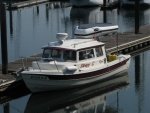AstoriaDave
New member
Five of six inflatable PFDs were pulled over the heads of swimmers caught in rough surf. One fatality resulted. Details and analysis here:
http://www.sailingscuttlebutt.com/2013/ ... -accident/
Their takeaway:
5) It is our experience that the auto-inflating PFD’s worn by our crew were not adequate in these rough conditions. Sailors should be aware that the force of wave action can pull the bladder away from the harness and over your head, even if thigh straps are worn. If forced to abandon their vessel, sailors should consider taking off their auto-inflating PFD’s and put on an offshore Type 1 lifejacket. If possible, leave the vessel with some type of additional floatation.
-----------
My takeaway: Admittedly, the surf these guys were forced to transit constituted an extreme situation. Nonetheless, I suspect PFD manufacturers will be addressing this problem. I hardly think in a sudden MOB situation my first act would be to toss a conventional strap on PFD at the swimmer. Better to fix fhe inflatable harness design.
http://www.sailingscuttlebutt.com/2013/ ... -accident/
Their takeaway:
5) It is our experience that the auto-inflating PFD’s worn by our crew were not adequate in these rough conditions. Sailors should be aware that the force of wave action can pull the bladder away from the harness and over your head, even if thigh straps are worn. If forced to abandon their vessel, sailors should consider taking off their auto-inflating PFD’s and put on an offshore Type 1 lifejacket. If possible, leave the vessel with some type of additional floatation.
-----------
My takeaway: Admittedly, the surf these guys were forced to transit constituted an extreme situation. Nonetheless, I suspect PFD manufacturers will be addressing this problem. I hardly think in a sudden MOB situation my first act would be to toss a conventional strap on PFD at the swimmer. Better to fix fhe inflatable harness design.

